 |
CATHEDRAL CITIES AND ABBEY TOWNS |
| << THE DESTRUCTION OF PREHISTORIC REMAINS |
| OLD INNS >> |
CHAPTER
IX
CATHEDRAL
CITIES AND ABBEY
TOWNS
There is
always an air of quietude and
restfulness about an ordinary
cathedral city.
Some of
our cathedrals are set in
busy places, in great centres of
population,
wherein
the high towering minster
looks down with a kind of
pitying compassion
upon
the toiling folk and invites
them to seek shelter and
peace and the
consolations
of religion in her quiet
courts. For ages she
has watched over the
city
and
seen generation after
generation pass away. Kings
and queens have come to
lay
their
offerings on her altars, and
have been borne there
amid all the pomp of
stately
mourning
to lie in the gorgeous tombs
that grace her choir.
She has seen it all--
times
of pillage and alarm, of robbery and
spoliation, of change and
disturbance,
but
she lives on, ever
calling men with her
quiet voice to look up in
love and faith
and
prayer.
But
many of our cathedral cities
are quite small places
which owe their very
life
and
existence to the stately
church which pious hands
have raised centuries
ago.
There
age after age the
prayer of faith, the anthems
of praise, and the
divine
services
have been offered.
In
the glow of a summer's
evening its heavenly
architecture stands out, a
mass of
wondrous
beauty, telling of the skill
of the masons and craftsmen of
olden days
who
put their hearts into their
work and wrought so surely
and so well. The
greensward
of the close, wherein the
rooks caw and guard their
nests, speaks of
peace
and joy that is not of
earth. We walk through the
fretted cloisters that
once
echoed
with the tread of sandalled
monks and saw them
illuminating and
copying
wonderful
missals, antiphonaries, and other
manuscripts which we prize so
highly
now.
The deanery is close at hand, a
venerable house of peace and learning;
and the
canons'
houses tell of centuries of
devoted service to God's Church,
wherein many
a
distinguished scholar, able preacher, and
learned writer has lived and
sent forth
his
burning message to the
world, and now lies at peace
in the quiet minster.
The
fabric of the cathedrals is often in
danger of becoming part and parcel
of
vanishing
England. Every one has
watched with anxiety the
gallant efforts that
have
been made to save
Winchester. The insecure
foundations, based on
timbers
that
had rotted, threatened to bring down
that wondrous pile of
masonry. And now
Canterbury
is in danger.
The
Dean and Chapter of Canterbury having
recently completed the
reparation of
the
central tower of the
cathedral, now find
themselves confronted
with
responsibilities
which require still heavier
expenditure. It has recently
been found
that
the upper parts of the two
western towers are in a dangerous
condition. All the
pinnacles
of these towers have had to be
partially removed in order to
avoid the risk
of
dangerous injury from falling stones, and
a great part of the external
work of the
two
towers is in a state of grievous
decay.
The
Chapter were warned by the
architect that they would
incur an anxious
responsibility
if they did not at once adopt
measures to obviate this
danger.
Further,
the architect states that
there are some fissures and
shakes in the
supporting
piers
of the central tower within
the cathedral, and that some
of the stonework
shows
signs of crushing. He further reports
that there is urgent need of
repair to the
nave
windows, the south transept
roof, the Warriors' Chapel,
and several other parts
of
the building. The nave
pinnacles are reported by
him to be in the last stage
of
decay,
large portions falling
frequently, or having to be
removed.
In
these modern days we run
"tubes" and under-ground railways in
close proximity
to
the foundations of historic
buildings, and thereby endanger their
safety. The
grand
cathedral of St. Paul,
London, was threatened by a "tube," and
only saved by
vigorous
protest from having its
foundations jarred and shaken by rumbling
trains
in
the bowels of the earth.
Moreover, by sewers and drains
the earth is made
devoid
of
moisture, and therefore is liable to
crack and crumble, and to disturb
the
foundations
of ponderous buildings. St. Paul's still
causes anxiety on this
account,
and
requires all the care and
vigilance of the skilful
architect who guards
it.
The
old Norman builders loved a
central tower, which they
built low and
squat.
Happily
they built surely and well,
firmly and solidly, as their
successors loved to
pile
course upon course upon their
Norman towers, to raise a
massive
superstructure,
and often crown them
with a lofty, graceful, but
heavy spire. No
wonder
the early masonry has, at
times, protested against this additional
weight,
and
many mighty central towers
and spires have fallen and
brought ruin on the
surrounding
stonework. So it happened at Chichester
and in several other
noble
churches.
St. Alban's tower very
nearly fell. There the
ingenuity of destroyers and
vandals
at the Dissolution had dug a
hole and removed the earth
from under one of
the
piers, hoping that it would
collapse. The old tower
held on for three
hundred
years,
and then the mighty mass
began to give way, and Sir
Gilbert Scott tells
the
story
of its reparation in 1870, of
the triumphs of the skill of
modern builders, and
their
bravery and resolution in saving
the fall of that great
tower. The greatest
credit
is
due to all concerned in that
hazardous and most difficult task. It had
very nearly
gone.
The story of Peterborough, and of
several others, shows that
many of these
vast
fanes which have borne the
storms and frosts of
centuries are by no means
too
secure,
and that the skill of wise
architects and the wealth of
the Englishmen of to-
day
are sorely needed to prevent
them from vanishing. If they
fell, new and modern
work
would scarcely compensate us
for their loss.
We
will take Wells as a model of a cathedral
city which entirely owes its
origin to
the
noble church and palace
built there in early times.
The city is one of the
most
picturesque
in England, situated in the
most delightful country, and
possessing the
most
perfect ecclesiastical buildings which
can be conceived. Jocelyn de
Wells,
who
lived at the beginning of
the thirteenth century
(1206-39), has for many
years
had
the credit of building the
main part of this beautiful
house of God. It is hard to
have
one's beliefs and early
traditions upset, but modern
authorities, with
much
reason,
tell us that we are all
wrong, and that another
Jocelyn--one Reginald
Fitz-
Jocelyn
(1171-91)--was the main
builder of Wells Cathedral.
Old documents
recently
discovered decide the question,
and, moreover, the style of
architecture is
certainly
earlier than the fully
developed Early English of
Jocelyn de Wells. The
latter,
and also Bishop Savaricus (1192-1205),
carried out the work,
but the whole
design
and a considerable part of the building
are due to Bishop Reginald
Fitz-
Jocelyn.
His successors, until the
middle of the fifteenth
century, went on
perfecting
the wondrous shrine, and in
the time of Bishop
Beckington Wells was in
its
full glory. The church, the
outbuildings, the episcopal palace, the
deanery, all
combined
to form a wonderful architectural
triumph, a group of buildings
which
represented
the highest achievement of
English Gothic art.
Since
then many things have
happened. The cathedral, like
all other ecclesiastical
buildings,
has passed through three
great periods of iconoclastic violence. It
was
shorn
of some of its glory at the
Reformation, when it was plundered of
the
treasures
which the piety of many
generations had heaped together. Then
the
beautiful
Lady Chapel in the cloisters
was pulled down, and the
infamous Duke of
Somerset
robbed it of its wealth and meditated
further sacrilege. Amongst
these
desecrators
and despoilers there was a mighty hunger
for lead. "I would that
they
had
found it scalding," exclaimed an
old chaplain of Wells; and to get
hold of the
lead
that covered the roofs--a
valuable commodity--Somerset and
his kind did
much
mischief to many of our cathedrals and
churches. An infamous bishop
of
York,
at this period, stripped his
fine palace that stood on
the north of York
Minster,
"for the sake of the lead
that covered it," and shipped it
off to London,
where
it was sold for �1000;
but of this sum he was
cheated by a noble duke,
and
therefore
gained nothing by his infamy.
During the Civil War it
escaped fairly well,
but
some damage was done,
the palace was despoiled; and at
the Restoration of
the
Monarchy
much repair was needed.
Monmouth's rebels wrought havoc.
They came
to
Wells in no amiable mood,
defaced the statues on the
west front, did
much
wanton
mischief, and would have
caroused about the altar had
not Lord Grey stood
before
it with his sword drawn, and
thus preserved it from the
insults of the
ruffians.
Then came the evils of
"restoration." A terrible renewing was
begun in
1848,
when the old stalls
were destroyed and much
damage done. Twenty
years
later
better things were
accomplished, save that the
grandeur of the west front
was
belittled
by a pipey restoration, when
Irish limestone, with its
harsh hue, was used
to
embellish it.
A
curiosity at Wells are the
quarter jacks over the
clock on the exterior north
wall
of
the cathedral. Local
tradition has it that the
clock with its accompanying
figures
was
part of the spoil removed
from Glastonbury Abbey. The
ecclesiastical
authorities
at Wells assert in contradiction to
this that the clock was
the work of one
Peter
Lightfoot, and was placed in the
cathedral in the latter part
of the fourteenth
century.
A minute is said to exist in
the archives of repairs to the
clock and figures
in
1418. It is Mr. Roe's opinion
that the defensive armour on
the quarter jacks
dates
from
the first half of the
fifteenth century, the plain
oviform breastplates and
basinets,
as well as the continuation of
the tassets round the
hips, being very
characteristic
features of this period. The
halberds in the hands of the
figures are
evidently
restorations of a later time. It
may be mentioned that in
1907, when the
quarter
jacks were painted, it was
discovered that though the
figures themselves
were
carved out of solid blocks
of oak hard as iron, the arms
were of elm bolted
and
braced thereon. Though such
instances of combined materials are
common
enough
among antiquities of medieval
times, it may yet be
surmised that the
jar
caused
by incessant striking may in time
have necessitated repairs to the
upper
limbs.
The arms are immovable, as
the figures turn on pivots
to strike.
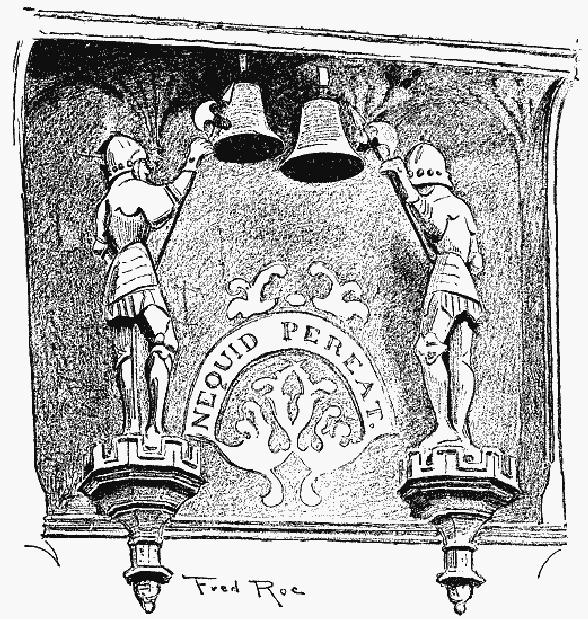
Quarter
Jacks over the Clock on
exterior of North Wall of
Wells Cathedral.
An
illustration is given of the
palace at Wells, which is one of
the finest examples
of
thirteenth-century houses existing in
England. It was begun by
Jocelyn. The
great
hall, now in ruins, was
built by Bishop Burnell at
the end of the
thirteenth
century,
and was destroyed by Bishop Barlow in
1552. The chapel is
Decorated.
The
gatehouse, with its drawbridge,
moat, and fortifications, was constructed
by
Bishop
Ralph, of Shrewsbury, who
ruled from 1329 to 1363.
The deanery was built
by
Dean Gunthorpe in 1475, who was
chaplain to Edward IV. On the
north is the
beautiful
vicar's close, which has
forty-two houses, constructed mainly by
Bishop
Beckington
(1443-64), with a common
hall erected by Bishop Ralph
in 1340 and a
chapel
by Budwith (1407-64), but
altered a century later. You
can see the
old
fireplace,
the pulpit from which one of
the brethren read aloud
during meals, and an
ancient
painting representing Bishop
Ralph making his grant to
the kneeling
figures,
and some additional figures
painted in the time of Queen
Elizabeth.
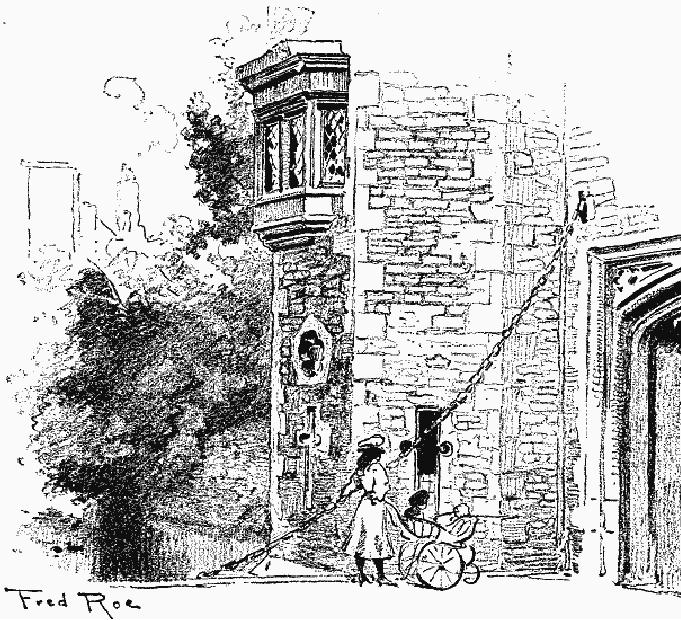
The
Gate House, Bishop's Palace,
Wells
When
we study the cathedrals of
England and try to trace the
causes which led to
the
destruction of so much that
was beautiful, so much of
English art that
has
vanished,
we find that there were
three great eras of iconoclasm.
First there were
the
changes wrought at the time
of the Reformation, when a rapacious
king and his
greedy
ministers set themselves to
wring from the treasures of
the Church as much
gain
and spoil as they were able.
These men were guilty of the
most daring acts of
shameless
sacrilege, the grossest robbery.
With them nothing was
sacred. Buildings
consecrated
to God, holy vessels used in
His service, all the
works of sacred art,
the
offerings
of countless pious benefactors were
deemed as mere profane things to
be
seized
and polluted by their sacrilegious
hands. The land was full of
the most
beautiful
gems of architectural art,
the monastic churches. We can
tell something of
their
glories from those which
were happily spared and
converted into cathderals or
parish
churches. Ely, Peterborough
the pride of the Fenlands,
Chester, Gloucester,
Bristol,
Westminster, St. Albans,
Beverley, and some others
proclaim the grandeur
of
hundreds of other magnificent
structures which have been
shorn of their leaden
roofs,
used as quarries for
building-stone, entirely removed and
obliterated, or left
as
pitiable ruins which still
look beautiful in their
decay. Reading,
Tintern,
Glastonbury,
Fountains, and a host of others
all tell the same
story of pitiless
iconoclasm.
And what became of the
contents of these churches?
The contents
usually
went with the fabric to
the spoliators. The halls of
country-houses were
hung
with altar-cloths; tables and beds
were quilted with copes;
knights and squires
drank
their claret out of chalices
and watered their horses in
marble coffins. From
the
accounts of the royal jewels
it is evident that a great deal of Church
plate was
delivered
to the king for his
own use, besides which
the sum of �30,360
derived
from
plate obtained by the
spoilers was given to the
proper hand of the
king.
The
iconoclasts vented their
rage in the destruction of stained
glass and beautiful
illuminated
manuscripts, priceless tomes and costly
treasures of exceeding rarity.
Parish
churches were plundered
everywhere. Robbery was in the
air, and clergy and
churchwardens
sold sacred vessels and appropriated
the money for
parochial
purposes
rather than they should be
seized by the king.
Commissioners were sent to
visit
all the cathedral and parish
churches and seize the
superfluous ornaments
for
the
king's use. Tithes, lands,
farms, buildings belonging to
the church all went
the
same
way, until the hand of
the iconoclast was stayed, as there was
little left to steal
or
to be destroyed. The next
era of iconoclastic zeal was
that of the Civil War
and
the
Cromwellian period. At Rochester
the soldiers profaned the
cathedral by using
it
as a stable and a tippling place, while
saw-pits were made in the
sacred building
and
carpenters plied their trade. At
Chichester the pikes of the
Puritans and their
wild
savagery reduced the interior to a
ruinous desolation. The
usual scenes of mad
iconoclasm
were enacted--stained glass
windows broken, altars
thrown down, lead
stripped
from the roof, brasses and
effigies defaced and broken. A
creature named
"Blue
Dick" was the wild leader of
this savage crew of
spoliators who left little
but
the
bare walls and a mass of
broken fragments strewing
the pavement. We need
not
record
similar scenes which took
place almost everywhere.
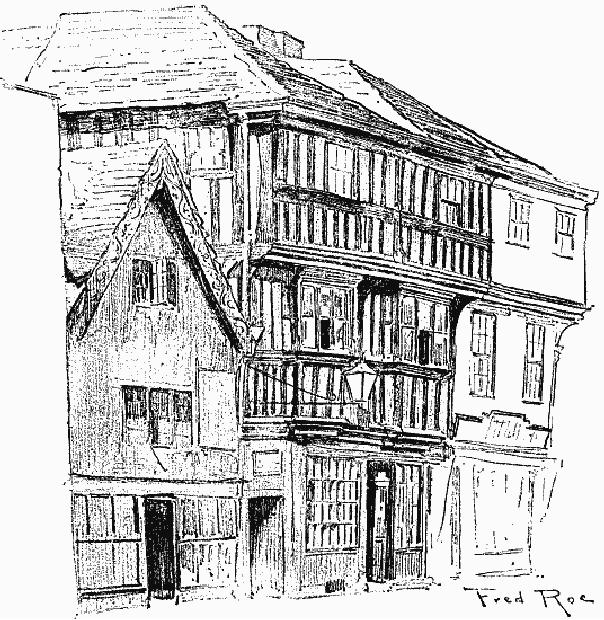
House
in which Bishop Hooper was
imprisoned, Westgate Street,
Gloucester
The
last and grievous rule of
iconoclasm set in with the
restorers, who worked
their
will
upon the fabric of our
cathedrals and churches and did so much
to obliterate all
the
fragments of good architectural work
which the Cromwellian
soldiers and the
spoliators
at the time of the
Reformation had left. The
memory of Wyatt and
his
imitators
is not revered when we see
the results of their work on
our ecclesiastical
fabrics,
and we need not wonder that
so much of English art has
vanished.
The
cathedral of Bristol suffered
from other causes. The
darkest spot in the history
of
the city is the story of
the Reform riots of 1831,
sometimes called "the
Bristol
Revolution,"
when the dregs of the
population pillaged and plundered,
burnt the
bishop's
palace, and were guilty of the
most atrocious
vandalism.
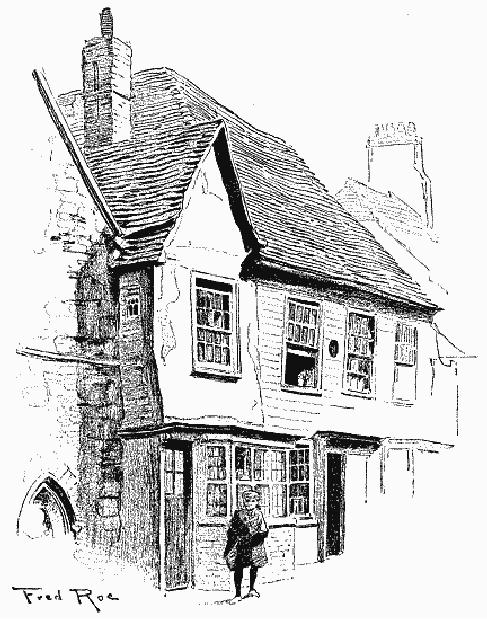
The
"Stone House," Rye,
Sussex
The
city of Bath, once the rival
of Wells--the contention between
the monks of St.
Peter
and the canons of St. Andrews at
Wells being hot and
fierce--has many
attractions.
Its minster, rebuilt by
Bishop Oliver King of Wells
(1495-1503), and
restored
in the seventeenth century, and also in
modern times, is not a
very
interesting
building, though it lacks
not some striking features,
and certainly
contains
some fine tombs and
monuments of the fashionable
folk who flocked to
Bath
in the days of its splendour.
The city itself abounds in
interest. It is a gem of
Georgian
art, with a complete homogeneous
architectural character of its
own
which
makes it singular and unique. It is full
of memories of the great folks
who
thronged
its streets, attended the Bath and
Pump Room, and listened to sermons
in
the
Octagon. It tells of the
autocracy of Beau Nash, of Goldsmith,
Sheridan, David
Garrick,
of the "First Gentleman of
Europe," and many others
who made Bath
famous.
And now it is likely that
this unique little city
with its memories and
its
charming
architectural features is to be mutilated
for purely commercial
reasons.
Every
one knows Bath Street with
its colonnaded loggias on
each side terminated
with
a crescent at each end, and leading to
the Cross Bath in the
centre of the
eastern
crescent. That the original
founders of Bath Street regarded it as
an
important
architectural feature of the
city is evident from the
inscription in
abbreviated
Latin which was engraved on
the first stone of the street
when laid:--
PRO
VRBIS
DIG: ET AMP:
H�C
PON: CVRAV:
SC:
DELEGATI
A:
D: MDCCXCI.
I:
HORTON, PRAET:
T:
BALDWIN, ARCHITECTO.
which
may be read to the effect
that "for the dignity and
enlargement (of the
city)
the
delegates I. Horton, Mayor, and T.
Baldwin, architect, laid
this (stone) A.D.
1791."
It
is actually proposed by the
new proprietors of the Grand
Pump Hotel to
entirely
destroy
the beauty of this street by
removing the colonnaded
loggia on one side of
this
street and constructing a new
side to the hotel two or
three storeys higher,
and
thus
to change the whole character of
the street and practically
destroy it. It is a
sad
pity,
and we should have hoped that
the city Council would
have resisted very
strongly
the proposal that the
proprietors of the hotel
have made to their body.
But
we
hear that the Council is
lukewarm in its opposition to
the scheme, and has
indeed
officially approved it. It is
astonishing what city and
borough councils will
do,
and this Bath Council has
"the discredit of having,
for purely commercial
reasons,
made the first move
towards the destruction
architecturally of the
peculiar
charm
of their unique and beautiful
city."42
Evesham
is entirely a monastic town. It sprang up
under the sheltering walls
of the
famous
abbey--
A
pretty burgh and such as
Fancy loves
For
bygone grandeurs.
This
abbey shared the fate of
many others which we have
mentioned. The Dean of
Gloucester
thus muses over the
"Vanished Abbey":--
"The
stranger who knows nothing
of its story would surely
smile if he
were
told that beneath the grass
and daisies round him were
hidden the
vast
foundation storeys of one of the
mightiest of our proud
medi�val
abbeys;
that on the spot where he
was standing were once
grouped a
forest
of tall columns bearing up
lofty fretted roofs; that
all around
once
were altars all agleam with
colour and with gold; that
besides the
many
altars were once grouped in
that sacred spot chauntries
and
tombs,
many of them marvels of
grace and beauty, placed there in
the
memory
of men great in the service of
Church and State--of
men
whose
names were household words
in the England of our
fathers; that
close
to him were once stately
cloisters, great monastic
buildings,
including
refectories, dormitories, chapter-house,
chapels, infirmary,
granaries,
kitchens--all the varied
piles of buildings which
used to
make
up the hive of a great
monastery."
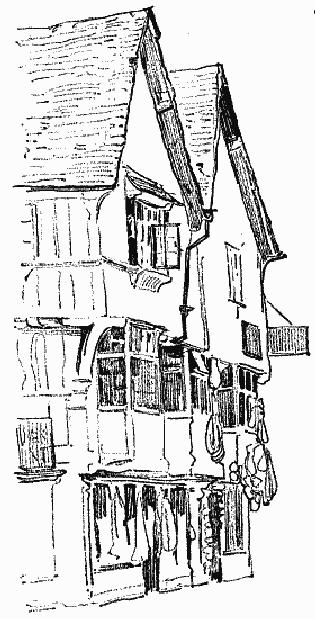
It
was commenced by Bishop Egwin, of
Worcester, in 702 A.D., but
the era of its
great
prosperity set in after the
battle of Evesham when Simon
de Montford was
slain,
and his body buried in the
monastic church. There was
his shrine to which
was
great pilgrimage, crowds flocking to
lay their offerings there;
and riches
poured
into the treasury of the
monks, who made great
additions to their house, and
reared
noble buildings. Little is
left of its former grandeur.
You can discover part of
the
piers of the great central tower,
the cloister arch of Decorated
work of great
beauty
erected in 1317, and the
abbey fishponds. The bell
tower is one of the
glories
of Evesham. It was built by the
last abbot, Abbot Lichfield, and
was not
quite
completed before the
destruction of the great abbey church
adjacent to it. It is
a
grand specimen of Perpendicular
architecture.
Fifteenth-century
House, Market Place,
Evesham
At
the corner of the Market
Place there is a picturesque
old house with gable and
carved
barge-boards and timber-framed arch, and
we see the old Norman
gateway
named
Abbot Reginald's Gateway,
after the name of its
builder, who also
erected
part
of the wall enclosing the
monastic buildings. A timber-framed
structure now
stretches
across the arcade, but a
recent restoration has
exposed the Norman
columns
which support the arch.
The Church House, always an
interesting building
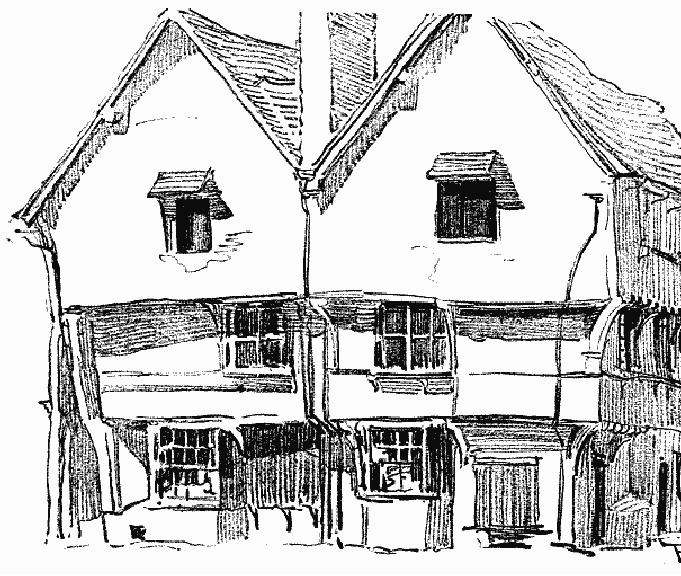
in
old towns and villages,
wherein church ales and
semi-ecclesiastical functions
took
place, has been restored. Passing
under the arch we see
the two churches in
one
churchyard--All Saints and St.
Laurence. The former has
some Norman work
at
the inner door of the
porch, but its main
construction is Decorated and
Perpendicular.
Its most interesting feature
is the Lichfield Chapel,
erected by the
last
abbot, whose initials and the arms of
the abbey appear on escutcheons on
the
roof.
The fan-tracery roof is
especially noticeable, and the good
modern glass. The
church
of St. Laurence is entirely
Perpendicular, and the chantry of
Abbot
Lichneld,
with its fan-tracery
vaulting, is a gem of English
architecture.
Fifteenth-century
House, Market Place,
Evesham
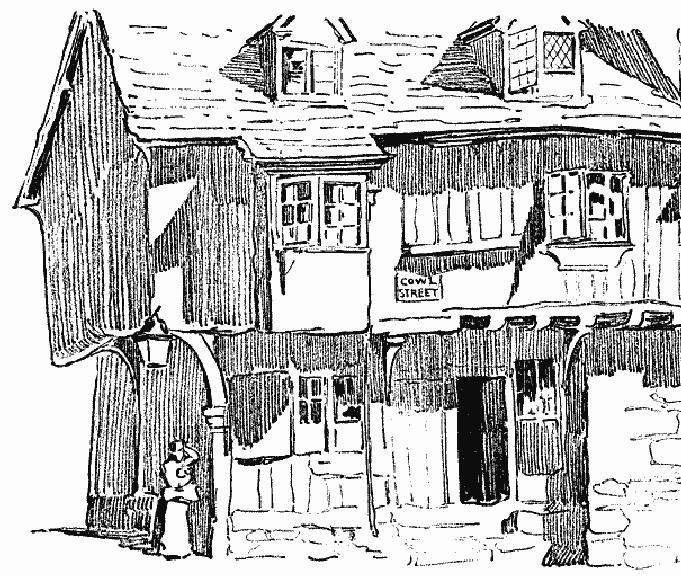
Fifteenth-century
House in Cowl Street,
Evesham
Amongst
the remains of the abbey
buildings may be seen the
Almonry, the
residence
of the almoner, formerly
used as a gaol. An interesting stone
lantern of
fifteenth-century
work is preserved here. Another abbey
gateway is near at hand,
but
little evidence remains of
its former Gothic work. Part
of the old wall built
by
Abbot
William de Chyryton early in
the fourteenth century
remains. In the town
there
is a much-modernized town hall, and near
it the old-fashioned Booth
Hall, a
half-timbered
building, now used as shops
and cottages, where formerly
courts
were
held, including the court of
pie-powder, the usual
accompaniment of every
fair.
Bridge Street is one of the most
attractive streets in the
borough, with its
quaint
old house, and the famous
inn, "The Crown." The
old house in Cowl Street
was
formerly the White Hart
Inn, which tells a curious
Elizabethan story about
"the
Fool
and the Ice," an incident
supposed to be referred to by Shakespeare
in Troilus
and
Cressida (Act
iii. sc. 3): "The
fool slides o'er the ice that
you should break."
The
Queen Anne house in the High
Street, with its
wrought-iron railings and
brackets,
called Dresden House and Almswood, one of
the oldest
dwelling-houses
in
the town, are worthy of
notice by the students of
domestic architecture.
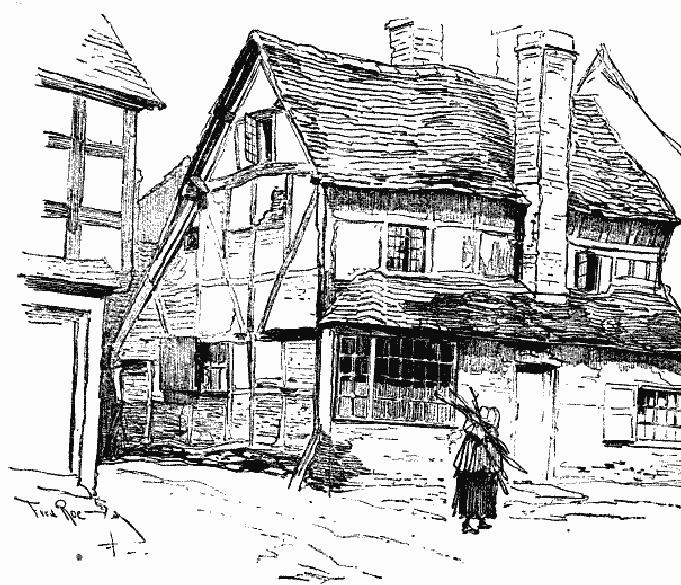
Half-timber
House, Alcester,
Warwick
Table of Contents:
- INTRODUCTION
- THE DISAPPEARANCE OF ENGLAND
- OLD WALLED TOWNS
- IN STREETS AND LANES
- OLD CASTLES
- VANISHING OR VANISHED CHURCHES
- OLD MANSIONS
- THE DESTRUCTION OF PREHISTORIC REMAINS
- CATHEDRAL CITIES AND ABBEY TOWNS
- OLD INNS
- OLD MUNICIPAL BUILDINGS
- OLD CROSSES
- STOCKS AND WHIPPING-POSTS
- OLD BRIDGES
- OLD HOSPITALS AND ALMSHOUSES
- VANISHING FAIRS
- THE DISAPPEARANCE OF OLD DOCUMENTS
- OLD CUSTOMS THAT ARE VANISHING
- THE VANISHING OF ENGLISH SCENERY
- CONCLUSION